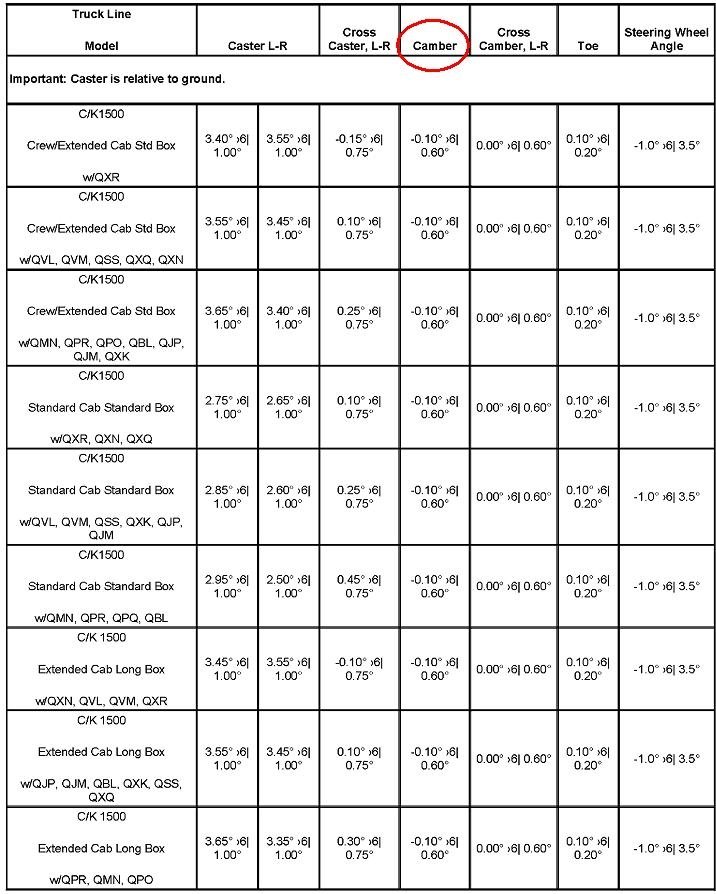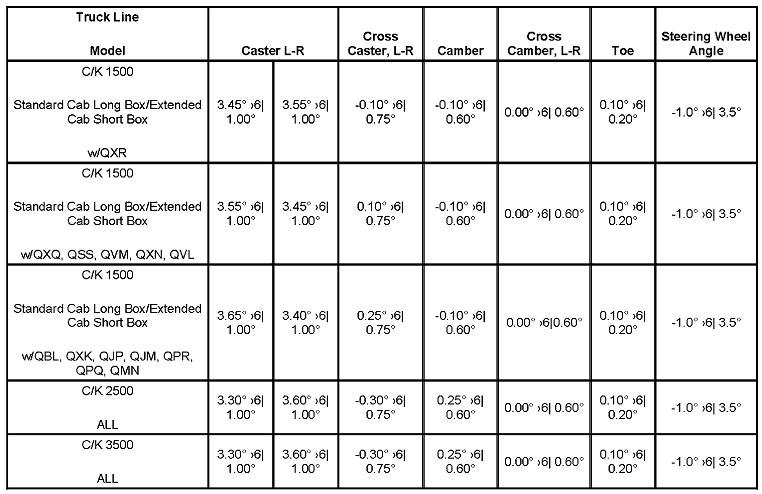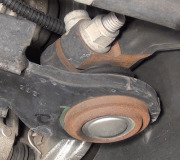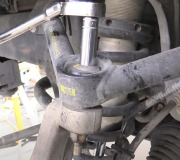All bets are off when the vehicle is not at the suspension ride height as designed, so there is going to be miserable tire wear and handling, but the numbers should still look okay on the alignment computer. You'll have to be more specific about what is happening. It sounds like the mechanic either dumbed it down to make it understandable, or something got lost in translation. Adjusting something on one side shouldn't affect anything on the other side. The only thing that interacts is if you have torsion bar front springs, adjusting one up or down to get it to specs will raise or lower that corner of the truck, and that causes the other side to tip too, but that only applies if you have upper and lower control arms. If you have a solid front axle, from ball joints to ball joints, that suspension system is not affected by height changes.
When you have upper and lower control arms, (short-long arm, "SLA") suspension system, those arms, the frame rail, and the spindle form the four sides of a parallelogram with very specific geometric angles designed in. That is what you upset when ride height is altered. If you look closely at the lower control arm, you'll see it is very nearly perfectly parallel to the ground, but the upper arm is angled down a lot as it goes out to the upper ball joint. That angle causes the top of the spindle and wheel to tip in and out on top as the truck body bounces up and down. That reduces how much the tire scrubs sideways across the road surface and is what greatly reduces tire wear.
The problem comes in when the vehicle is lifted by installing longer coil springs or turning up torsion bar springs. The spindle and wheel move down, and the upper control arm angles down a lot more than before. As the control arm arcs inward, that tips the wheel in on top. The alignment angle in question is "camber". Most vehicles call for slightly positive camber, meaning the wheel is tipped out on top a little. Perfectly straight up and down is 0.00 degrees, and if you could imagine the wheel laying flat on its side, that would be 90.00 degrees. Typical camber specs for most vehicles including GM trucks are around 0.25 to 0.50 degrees. The chart below shows all versions for your truck as between -0.10 degrees to 0.60 degrees. They don't list a preferred spec.
The other way to lift the front is with "drop spindles". Those leave all the suspension system parts alone, along with the critical angles. Just the wheel and tire are lowered on the spindle. This would have the same effect as parking the truck with the tires sitting on 2x4s. Everything is raised up, but nothing else has changed. This presents a different problem. The angle in question now is "scrub radius". That is seen as an imaginary line drawn between the two ball joints. The line intersect the road surface at a very specific point on the tire's tread. Lowering the spindle and tire tread has the same effect as installing tires with a larger outer diameter. Now that line intersects the road surface further out on the tread.
The tire tread is split into two halves when looking at where it contacts the road. From that point outward, that part of the tire want to pull away from the center of the truck. From that point inward, that part of the tread wants to pull toward the center of the truck. Scrub radius is designed so those two forces very nearly cancel each other out. That is what causes a tire to not momentarily pull to one side when you hit a bump or pot hole. When that balance is upset, it can still be offset by the same actions of the other tire, but only when both hit the same bump at the same time, as in when crossing an intersection or railroad tracks. At most other times it causes a "busy" feeling, meaning you have to constantly be aware of the vehicle drifting off to one side, and you're constantly correcting it. That makes for a very tiring vehicle to drive.
The other alignment angle is "caster". That is best visualized by looking at how the fork of a bicycle is angled rearward on top. When you put weight on it, that is what lets you ride no-handed. Caster makes the wheel squirt out to straight ahead. On a car or truck, we use "positive caster", meaning the upper ball joint is rearward in relation to the lower ball joint. Except in extreme cases, caster is not much of a tire wear angle, but it does affect pulling. Positive caster makes each wheel want to turn toward the center of the truck when the vehicle's weight is placed on it. 3.00 degrees has been a typical value for most vehicles for many decades. That is enough to make steering extremely difficult but improves steering wander. That became an issue by the mid '60s when we started driving faster. In response to that hard steering, that is why power steering was added. Before that, with negative caster, you could steer a big heavy truck with no power steering.
With 3.00 degrees caster and the truck's weight on the tires, that force is so great, you would not be able to pull the wheel and tire straight by hand. The same is true of both front wheels, but it's when the steering linkage connects them both that they offset each other. There's five ways to describe how caster affects pulling and handling, but all of them require you to visualize, or imagine what is happening. Sufficient for this story is to explain how these adjustments are made on your truck. The control arms are large triangles with the ball joint at one of the points. The other two pivot on rubber bushings, and both of those on one of the control arms can be adjusted in closer to the frame or out further from the frame. As you move one or both in, the wheel tips in on top. That again is "camber". Either bushing can be moved to get camber to specs.
The problem is with caster. To increase caster, the upper ball joint has to be moved rearward. That is done with a combination of moving the front control arm bushing out, and / or moving the rear one in. Moving either bushing changes camber and caster at the same time. Camber has very little tolerance because tipping the wheel too much creates an accelerated tire wear issue on one edge of the tread. Caster is more forgiving, but it is important that it be the same on both sides. Positive caster causes that wheel to want to turn toward the center of the truck, and more caster makes it want to do that a lot harder. Here again, it's most important for caster to be equal on both sides so those forces cancel each other out. When caster is just 0.50 degrees lower on one wheel, the truck is going to pull toward that wheel when you let go of the steering wheel, so while it's not critical for tire wear, it is for pulling to one side.
Where it sounds like you're running into trouble is caster and camber can be adjusted to specs on one wheel by moving the two bushings in and out, but while camber can be made nearly perfect, and caster can wind up being acceptable, we still need to have both of those values the same as on the other side. That means four angles have to be set by moving four adjustments. You might not be able to get caster high enough on one side to match the other side, and you might not be able to get caster low enough on the other side to match the first side. This is where I need to know exactly what the specialist is having trouble with. If you could post a copy of the alignment printout, I can interpret that for you and perhaps figure out what is causing the trouble. If there is no printout, I need to know what you have for camber and caster on each front wheel.
The final adjustments are always "toe" after everything else is done. That is simply locking the steering wheel straight ahead, then adjusting each front wheel to match that and be nearly straight ahead, plus turned toward the center of the truck just a little. That makes them perfectly parallel when driving down the road, due to road forces pulling the wheels back a little. Adjusting toe on one wheel doesn't affect toe on the other wheel, but both have to be adjusted individually to specs to insure the steering wheel is striaght and for best tire wear.
"Total toe" is just the sum of both toe readings, and that is just as important as camber to good tire wear. While camber always causes edge wear to that one tire, total toe always causes equal wear to both tires on that axle, regardless of which one or both is misadjusted. When total toe is excessively out-of-specs, it creates a feather-edge pattern on both tires, and often on just half of the tread. You'll feel the tread is fairly smooth when running your hand around it one way, but then you'll feel the sharp, raised edges on each block of rubber when running your hand the other way. Often you'll feel that too when running your hand across the tread from inside edge to outside edge.
The steering linkage is designed to be nearly parallel to the lower control arm, with the ball and socket of the inner tie rod end nearly inline with the lower control arm bushing, then, those are offset just a little to fine tune how the wheel reacts when cornering at high speeds. Body roll causes the suspension to move to a different height, and that is what affects handling and braking at high speeds. When the ride height is not at specs, you can expect to see that feather-edge wear pattern on the front tires. Ford had a real big problem with that on their trucks and vans with the twin I-beam suspension. That was a design problem, but there were things we could do to reduce that wear. Those repairs were only effective though when they were at the design ride height.
We also see these handling and tire wear problems when the springs are sagged from age. Every shop has a small book that lists every car and light truck model and year, where to take the height measurements, and what they should be. Most conscientious mechanics won't align a vehicle with sagged springs because they know the customer is still going to be unhappy with the results. Even though the numbers on the alignment computer screen look good, they only pertain to a vehicle that is standing still. Correct ride height is the final variable that affects tire wear and handling for vehicles that are bouncing up and down as they buzz down the road.
Images (Click to make bigger)
SPONSORED LINKS
Tuesday, December 31st, 2019 AT 1:20 PM





